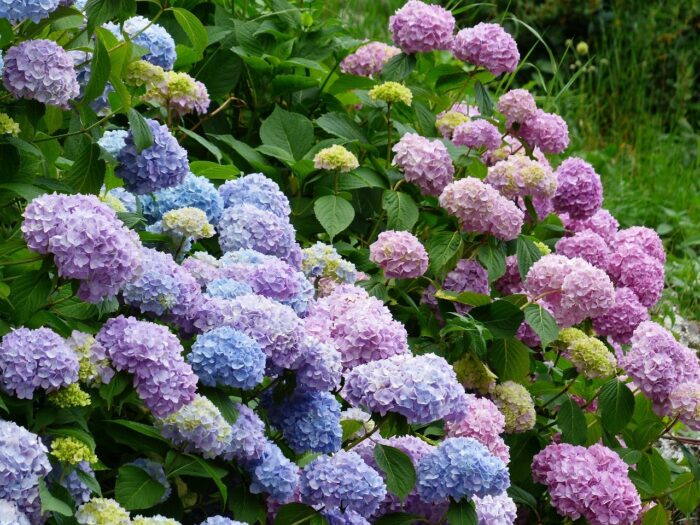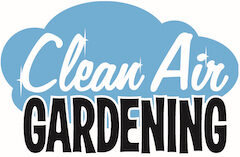
by Jennifer Poindexter
Would you like to plant flowering shrubs around your home? Many people prefer flowering shrubs to basic foliage because it adds texture and color to their landscape at different times throughout the year.
One shrub which deserves your attention is the hydrangea. They have beautiful flowers and come in a variety of colors. If you’d like to add hydrangeas to your yard or garden, here’s what you must know to grow and care for them.
Growing Conditions for Hydrangeas
Hydrangeas are a flowering shrub which can grow to be as tall as 15 feet. They come in multiple color options and seem to thrive in planting zones three through nine.
As with most plants, hydrangeas have a few specific needs when picking the perfect location for planting.
To begin, they require well-draining soil. They don’t handle sitting in water for long periods of time. Therefore, the soil must be light, fluffy, and able to drain moisture away from the plant fairly quickly.
If the soil feels too dense during planting, be sure to amend it before placing the hydrangea in its place. Without this extra step, it can cause problems down the road.
You also want to be sure the soil is high in nutrients because hydrangeas are heavy feeders and need to be able to pull necessary nutrients from the soil they’re surrounded by.
Finally, ensure hydrangeas are planted where they receive morning sun but are protected from the hottest parts of the day.
You can plant them near a tree but never plant them directly under one. This will cause the hydrangea to be forced to compete for food and water.
By providing these basic needs in a grow space, your hydrangeas should be set-up to thrive and produce beauty around your home in coming years.
How to Plant Hydrangeas
Hydrangeas should be planted in fall or early spring. This will allow the roots time to develop before they begin the blooming process in their new home.
When planting, be sure to dig the hole two feet broader than the plant’s root ball. Place the plant in the hole and cover back up with quality soil.
Ensure you mound the dirt around the plant. This will encourage water to drain away from the plant and help to avoid soggy roots.
If you’re planting multiple hydrangeas, be sure to leave anywhere from three to ten feet between each plant. The amount of space needed will vary by variety and how large the plant is supposed to become.
Once you have hydrangeas in the ground, you’re in an excellent position to begin propagating new plants. There are a variety of ways to go about this, but I’m going to share one of the easiest methods for the new gardener or for those who prefer simplicity.
If you leave extra room around your hydrangeas, it gives you space to propagate. Dig a small ditch next to the established hydrangea plant.
From there, lean one of the plant’s branches towards the ditch. Scratch the branch to display the fleshy inside of the plant. Place the scratched portion of the plant on the soil.
Cover the branch with soil and place a bucket of dirt on top of the branch, or any heavy object, to hold this portion of the plant in place in the ditch.
Give the plant approximately a month to establish roots while buried in the ditch. Once the plant looks established, you can dig it up and transplant anywhere you choose. Continue the same propagation process to create as many new hydrangeas as you desire.
Planting hydrangeas is a simple process and so is propagating new plants from those already established on your property. Hopefully this will help you beautify your landscape with ease and while maintaining a budget.
Caring for Hydrangeas
Hydrangeas are simple plants to care for. They need to be watered correctly, fertilized based on their variety, pruned, and mulched.
The first step in caring for hydrangeas is to water them right after planting. They should be watered until their roots have become well established in their new grow space. This might take a few weeks.
After this has occurred, you can reduce watering to only once or twice per week. Use the deep watering method to ensure you provide enough water without overdoing it.
The amount of water your hydrangea needs will vary by variety, but one of the biggest tips in watering this plant is to avoid getting the leaves wet.
This can draw disease. Therefore, it’s a good idea to use soaker hoses to water beneath the plant or water early in the mornings.
By watering at this time, it will give the plants a chance to dry out during the heat of the day before the cold night air swoops in again and can encourage disease.
The next step in caring for hydrangeas is fertilizing them according to their variety. The large leafed hydrangea plants only require light fertilizing in late spring and early summer.
Some varieties of this plant appear loose and produce clusters of flowers. They require fertilizing in late spring and mid-summer.
Finally, the snowball varieties of hydrangeas should only be fertilized in late winter. By following this general schedule, based upon your variety of plant, they should receive the necessary nutrients needed to thrive.
The third step to caring for hydrangeas is to prune them. Again, this will vary by variety of the plant. Most varieties of hydrangeas should be pruned in fall or early spring.
However, the varieties which appear loose while producing clusters of flowers, should only be pruned in the winter.
When pruning, a general rule of thumb is to only prune the dead. Don’t prune to shape the shrub. Find the oldest stems and cut them back at the base of the plant. This will encourage the plant to maintain its “bushy” appearance.
If you’ve inherited a hydrangea plant that is really old or in overall bad shape, don’t give up on it. Instead, cut the entire plant back to its base.
It will regrow and appear fresh and new again. Be aware, the plant may not bloom for a few years after such pruning.
Some varieties of hydrangeas need to be deadheaded when in bloom while others don’t. Be aware of this when choosing which variety to grow.
The only remaining step to caring for hydrangeas is mulching. Mulch can help the plant retain moisture, but it also serves as an insulator over winter. Therefore, it’s recommended to mulch your hydrangeas in the fall to protect their root systems when growing in a colder climate.
Before we wrap up our section on how to care for hydrangeas, I wanted to share an interesting fact. Hydrangeas can be manipulated to change the color bloom they produce.
If you buy a hydrangea and want a different color after purchasing, you don’t need to purchase more plants.
Instead, you can amend the soil to change the color of the bloom. Be sure to wait a couple of years after planting before you try this to ensure the plant is settled in its grow space.
Once you know the plant is thriving, you can make the soil more acidic to produce blue flowers. More alkaline soil produces pink flowers, but the hydrangeas which produce white flowers can’t be manipulated.
Hydrangeas can be easily propagated, easily cared for, and also easily influenced to change the color blooms you receive. It’s easy to understand why many gardeners love this plant.
Garden Pests and Diseases for Hydrangeas
Though hydrangeas seem to be a simple plant to grow, with many unique qualities, there are a few pests and diseases you must be aware of.
The diseases which most commonly impact hydrangeas are leaf spot, blight, and powdery mildew. These are usually caused by a fungus.
You can avoid these diseases by increasing drainage and air flow around the plant. Also, be sure to remove any damaged portions of the plant if these diseases find your hydrangeas. They can also be treated with a fungicide.
The most common pests to impact hydrangeas are aphids, spider mites, and leaf tiers. Aphids and spider mites can be treated with an insecticide, in most cases.
You can also spray the plant with soapy water to dislodge the pests. Leaf tiers are a little more complicated.
This is a type of caterpillar which feeds on the blooms of the hydrangea plant. You’ll notice the leaves begin to curl as the pests feed.
Insecticides don’t work well for this pest because the curling leaf protects the bug. Instead, you can remove the curling leaves or hand-pick the pests from the plant.
These are the most common threats when growing hydrangeas. Keep a lookout for them to give your plant the greatest chance at thriving under your care.
Hydrangeas are an interesting plant. They can be a variety of sizes, produce multiple colors of blooms, and even be manipulated to change bloom color.
If this sounds thrilling to you, give this low-maintenance shrub a chance. You should be happy with the boost it can provide to your landscaping.
Learn More About Flowering Hydrangea Shrubs
https://extension.oregonstate.edu/gardening/flowers-shrubs-trees/general-care-hydrangeas
https://ohioline.osu.edu/factsheet/hyg-1263
https://extension.umd.edu/hgic/topics/guide-pruning-hydrangeas

